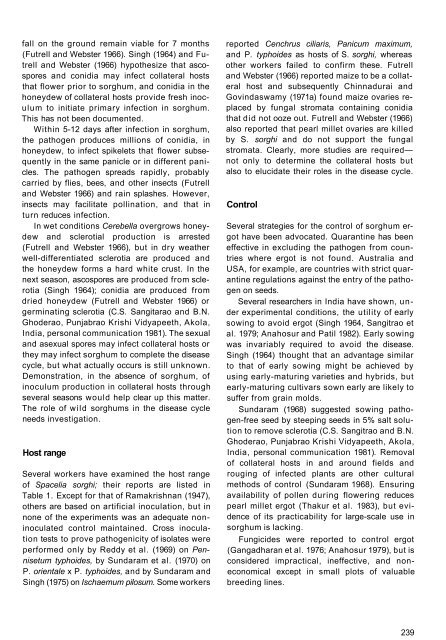Sorghum Diseases in India
Sorghum Diseases in India
Sorghum Diseases in India
Create successful ePaper yourself
Turn your PDF publications into a flip-book with our unique Google optimized e-Paper software.
fall on the ground rema<strong>in</strong> viable for 7 months<br />
(Futrell and Webster 1966). S<strong>in</strong>gh (1964) and Futrell<br />
and Webster (1966) hypothesize that ascospores<br />
and conidia may <strong>in</strong>fect collateral hosts<br />
that flower prior to sorghum, and conidia <strong>in</strong> the<br />
honeydew of collateral hosts provide fresh <strong>in</strong>oculum<br />
to <strong>in</strong>itiate primary <strong>in</strong>fection <strong>in</strong> sorghum.<br />
This has not been documented.<br />
With<strong>in</strong> 5-12 days after <strong>in</strong>fection <strong>in</strong> sorghum,<br />
the pathogen produces millions of conidia, <strong>in</strong><br />
honeydew, to <strong>in</strong>fect spikelets that flower subsequently<br />
<strong>in</strong> the same panicle or <strong>in</strong> different panicles.<br />
The pathogen spreads rapidly, probably<br />
carried by flies, bees, and other <strong>in</strong>sects (Futrell<br />
and Webster 1966) and ra<strong>in</strong> splashes. However,<br />
<strong>in</strong>sects may facilitate poll<strong>in</strong>ation, and that <strong>in</strong><br />
turn reduces <strong>in</strong>fection.<br />
In wet conditions Cerebella overgrows honeydew<br />
and sclerotial production is arrested<br />
(Futrell and Webster 1966), but <strong>in</strong> dry weather<br />
well-differentiated sclerotia are produced and<br />
the honeydew forms a hard white crust. In the<br />
next season, ascospores are produced from sclerotia<br />
(S<strong>in</strong>gh 1964); conidia are produced from<br />
dried honeydew (Futrell and Webster 1966) or<br />
germ<strong>in</strong>at<strong>in</strong>g sclerotia (C.S. Sangitarao and B.N.<br />
Ghoderao, Punjabrao Krishi Vidyapeeth, Akola,<br />
<strong>India</strong>, personal communication 1981). The sexual<br />
and asexual spores may <strong>in</strong>fect collateral hosts or<br />
they may <strong>in</strong>fect sorghum to complete the disease<br />
cycle, but what actually occurs is still unknown.<br />
Demonstration, <strong>in</strong> the absence of sorghum, of<br />
<strong>in</strong>oculum production <strong>in</strong> collateral hosts through<br />
several seasons would help clear up this matter.<br />
The role of wild sorghums <strong>in</strong> the disease cycle<br />
needs <strong>in</strong>vestigation.<br />
Host range<br />
Several workers have exam<strong>in</strong>ed the host range<br />
of Spacelia sorghi; their reports are listed <strong>in</strong><br />
Table 1. Except for that of Ramakrishnan (1947),<br />
others are based on artificial <strong>in</strong>oculation, but <strong>in</strong><br />
none of the experiments was an adequate non<strong>in</strong>oculated<br />
control ma<strong>in</strong>ta<strong>in</strong>ed. Cross <strong>in</strong>oculation<br />
tests to prove pathogenicity of isolates were<br />
performed only by Reddy et al. (1969) on Pennisetum<br />
typhoides, by Sundaram et al. (1970) on<br />
P. orientale x P. typhoides, and by Sundaram and<br />
S<strong>in</strong>gh (1975) on Ischaemum pilosum. Some workers<br />
reported Cenchrus ciliaris, Panicum maximum,<br />
and P. typhoides as hosts of S. sorghi, whereas<br />
other workers failed to confirm these. Futrell<br />
and Webster (1966) reported maize to be a collateral<br />
host and subsequently Ch<strong>in</strong>nadurai and<br />
Gov<strong>in</strong>daswamy (1971a) found maize ovaries replaced<br />
by fungal stromata conta<strong>in</strong><strong>in</strong>g conidia<br />
that did not ooze out. Futrell and Webster (1966)<br />
also reported that pearl millet ovaries are killed<br />
by S. sorghi and do not support the fungal<br />
stromata. Clearly, more studies are required—<br />
not only to determ<strong>in</strong>e the collateral hosts but<br />
also to elucidate their roles <strong>in</strong> the disease cycle.<br />
Control<br />
Several strategies for the control of sorghum ergot<br />
have been advocated. Quarant<strong>in</strong>e has been<br />
effective <strong>in</strong> exclud<strong>in</strong>g the pathogen from countries<br />
where ergot is not found. Australia and<br />
USA, for example, are countries with strict quarant<strong>in</strong>e<br />
regulations aga<strong>in</strong>st the entry of the pathogen<br />
on seeds.<br />
Several researchers <strong>in</strong> <strong>India</strong> have shown, under<br />
experimental conditions, the utility of early<br />
sow<strong>in</strong>g to avoid ergot (S<strong>in</strong>gh 1964, Sangitrao et<br />
al. 1979; Anahosur and Patil 1982). Early sow<strong>in</strong>g<br />
was <strong>in</strong>variably required to avoid the disease.<br />
S<strong>in</strong>gh (1964) thought that an advantage similar<br />
to that of early sow<strong>in</strong>g might be achieved by<br />
us<strong>in</strong>g early-matur<strong>in</strong>g varieties and hybrids, but<br />
early-matur<strong>in</strong>g cultivars sown early are likely to<br />
suffer from gra<strong>in</strong> molds.<br />
Sundaram (1968) suggested sow<strong>in</strong>g pathogen-free<br />
seed by steep<strong>in</strong>g seeds <strong>in</strong> 5% salt solution<br />
to remove sclerotia (C.S. Sangitrao and B.N.<br />
Ghoderao, Punjabrao Krishi Vidyapeeth, Akola,<br />
<strong>India</strong>, personal communication 1981). Removal<br />
of collateral hosts <strong>in</strong> and around fields and<br />
roug<strong>in</strong>g of <strong>in</strong>fected plants are other cultural<br />
methods of control (Sundaram 1968). Ensur<strong>in</strong>g<br />
availability of pollen dur<strong>in</strong>g flower<strong>in</strong>g reduces<br />
pearl millet ergot (Thakur et al. 1983), but evidence<br />
of its practicability for large-scale use <strong>in</strong><br />
sorghum is lack<strong>in</strong>g.<br />
Fungicides were reported to control ergot<br />
(Gangadharan et al. 1976; Anahosur 1979), but is<br />
considered impractical, <strong>in</strong>effective, and noneconomical<br />
except <strong>in</strong> small plots of valuable<br />
breed<strong>in</strong>g l<strong>in</strong>es.<br />
239








